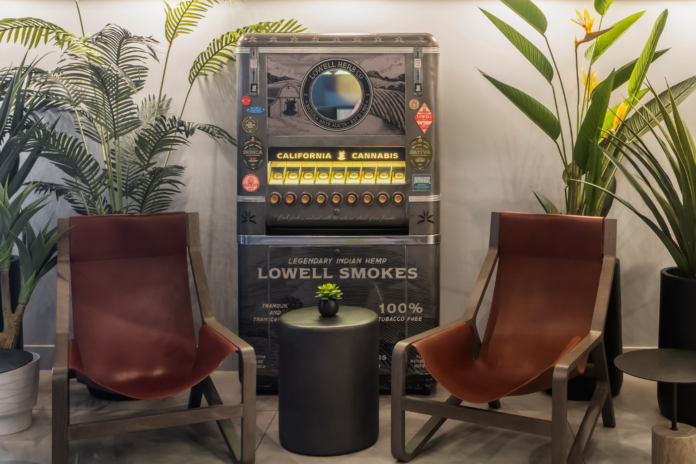In a rapidly evolving market, a dispensary’s aesthetic and operating culture do more than showcase products. They also can captivate customers and drive repeat business. Even small details can set apart retailers who thrive from those who just survive.
As in every other brick-and-mortar sector that deals directly with consumers, shops that sell cannabis and accessories ride trends that ebb and flow with larger societal movements. Features that were must-haves as recently as last year fall out of favor while new designs and processes emerge. A few endure, becoming permanent fixtures in the retail landscape; others evolve into shinier, newer versions of the original, and still others disappear. Staying in sync with the hot-or-not rollercoaster can be challenging.
That’s why many leading consultants recommend incorporating flexibility into at least some aspects of store designs. Movable fixtures allow operators to redefine floor plans and take better advantage of traffic flow or redirect the flow to higher-value merchandise. Semi-permanent installations allow operators to add seasonal or special-event interest.
Other trends we’ve noticed lately include multisensory engagement, new uses for technology, and an increasing emphasis on “time-of-day merchandising.” We asked a few leading consultants to bring the industry up to date on what’s trending in and phasing out.
Phasing out: Wasted space.
Trending in: Strategic layouts.
Cindy Lam, founder and principal designer at Remedy Design Group in Orange County, California, advises operators to create their store’s floor plan and merchandising before they start to build. “Consider the end result from the beginning: your offerings, customer journey and how you can be unique,” she said.
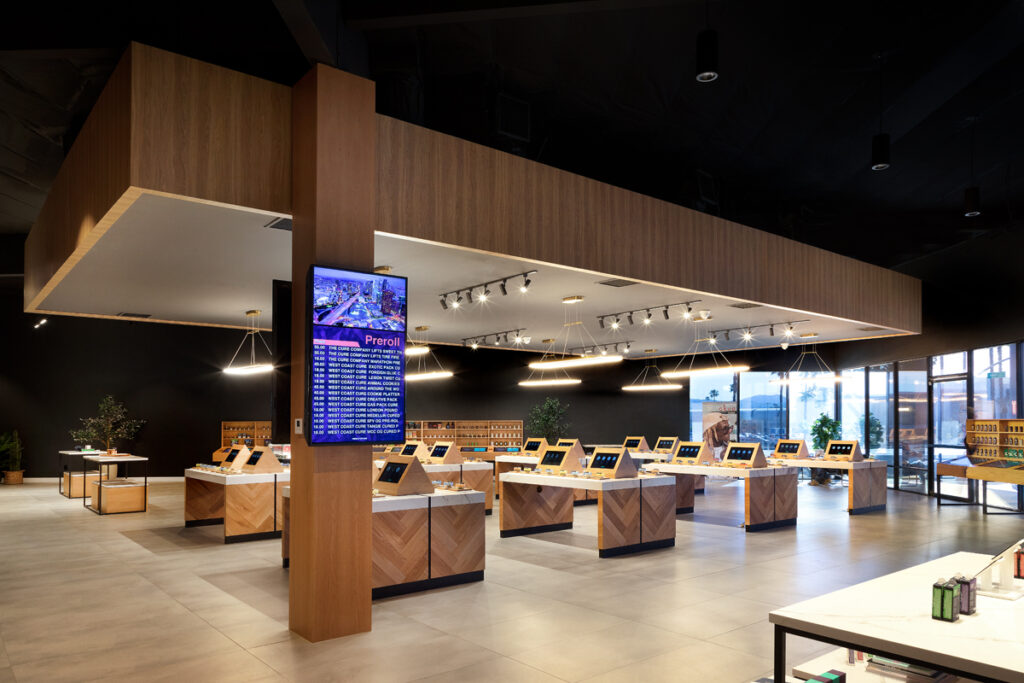
A significant—and sometimes forgotten—consideration is space. “Wide open expanses are a waste,” Lamb said. “You don’t need a dance floor in the middle of the store. Then you’re paying rent on unused real estate.”
In addition, she said, highlight the latest and most profitable merchandise and brand collaborations front and center, and place impulse buys within arm’s reach near the cashstands.
Phasing out: Bank-line boredom.
Trending in: Savvy seduction at the point of sale.
Think like many non-cannabis retailers do: Use point-of-sale lines to seduce and entertain customers while leaving a positive last impression, Lam suggested.
“Queues are great opportunities to upsell with last-minute impulse buys like rolling papers, matches, lighters, vapes, and gift baskets,” she said. “You also can showcase smaller items that customers might have missed while walking the store.”
Shoplifting concerns may be alleviated by investing in tiered displays with transparent but locked acrylic cases that secure samples. Lam created Remedy Displays’ cases for vape cartridges, batteries, pens, lighters, edibles, concentrates, grinders, and pipes. Units with jars for concentrates and edibles are tethered with security cables.
Phasing out: Appealing to everyone.
Trending in: Know thy shopper.
Journalists aren’t the only ones who need to heed the five Ws: who, what, when, where, and why. Answering those questions also can keep retailers in the green.
bBefore a design can take shape, operators must know the specifics of the demographics they intend to serve, when those people are likely to shop, what they are likely to buy, and what price points hit their sweet spot, said Lam, who previously worked as an in-house interior designer at Starbucks and Cole Haan-NY. “You’ve got to understand your community and what they crave,” she said. “Tourists and out-of-towners shop differently than local office workers.”
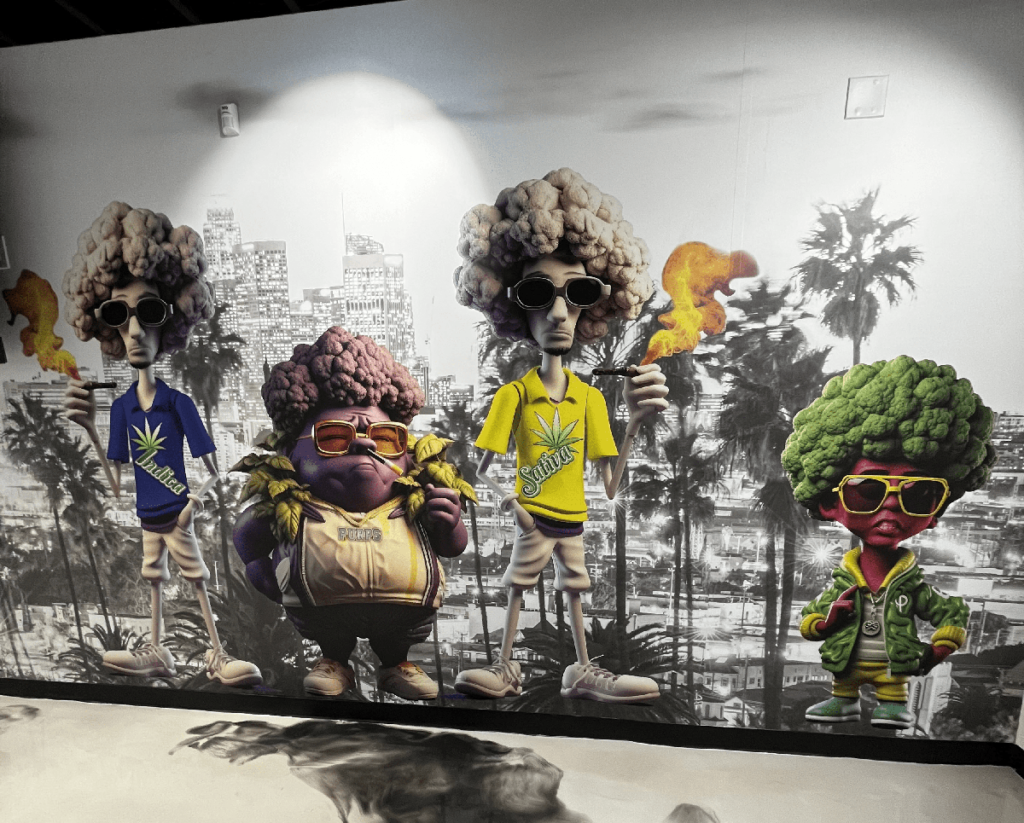
After opening, study the actual shopping paterns. “Focus on your highest-profit and most in-demand categories,” Lam advised, adding those are the items that should never be allowed to go out of stock. “Lessen your buy list for other categories.”
Beyond facts and figures, also be mindful of customers’ feedback. Follow their lead and cater to those who care most about your wares.
And signal who’s high on your list, according to Temeka Group co-founder and Chief Executive Officer Mike Wilson. For example, Broccoli Cannabis in California displays street-savvy portraits on exterior and interior walls to welcome its customer base wordlessly while weeding out those who’d be disinterested in the brands and product types the store offers.
Phasing out: Permanence.
Trending in: Flexibility.
A splashy design may be fabulous, but don’t commit so much money to its implementation that you’re married to it permanently. “Forever designs” can bore consumers and put a dent in a store’s ability to profit from trends.
Instead, build in flexibility from the start. A layout that allows—perhaps even encourages—displaying different products at different times permits operators to alter their merchandise and methods to respond to customers’ evolving needs and desires.
Those can change by the hour and the day, according to Lam. What appeals to the noon shopper may be different from what stokes the after-work customer. For example, “Social smokers tend to buy vape pens at the end of their workday or before the weekend,” she said. On the other hand, midday shoppers may be looking for an edible to provide a quick pick-me-up.
So, note the best times to bring out products that satisfy the needs of specific shopper groups, and move things around during the day. “Just like your city, your store has rush hours, and you’ve got to respond,” Lam said. Change your inventory and staff to maximize the opportunities.
Flexibility isn’t just about scheduling, though. Merchandise, too, should be flexible. Never underestimate the element of surprise in retail. Farnsworth Fine Cannabis in Great Barrington, Massachusetts, deliberately plans for its collectible lighters and ashtrays to sell out so the store can rotate the selection and surprise shoppers with merchandise they’ve never seen before the next time they pop in.
Phasing out: Forever merchandising.
Trending in: Perpetual pivoting.
You’ve put your heart and soul into your store, and yet it’s failing to thrive. Tepid sales may be due to a variety of factors, but one of the most common is failure to evolve with the market.
“Don’t stop researching what works and doesn’t,” Lam said. Your brands, price points and timing may be off for the audience that actually exists, not the one you hoped to attract or previously attracted. Tastes change. Trends come and go. Populations shift. And sales figures may mutate from hour to hour and day to day.
Don’t assume you know best. Get feedback from budtenders, floor managers, and customers to help define and address the issues, Lam suggested.
She advises patrolling the dispensary yourself at different times of the day and on different days of the week. “I’ve had clients who were disappointed in their sales, but after walking their space at different times of the day and week, lo and behold, they discovered they sometimes ran out of merchandise and had empty tables with no product,” she said.
If you dare, ask your investors, partners, or others you trust to drop by and serve as secret shoppers, then report their impressions. Then, be nimble and quick. Keep merchandise moving by constantly tweaking the mix in response to shoppers’ preferences.
Phasing out: Relying solely on visuals.
Trending in: Engaging all the senses.
“You’ve got to pick the right sounds and smells for the customer’s experience,” Lam said. “And there’s room to be playful.” As an example, she cited this sound decision: When customers cross the threshold at High Seas in Costa Mesa, California, a sensor activates the sound of ocean waves and seagulls. The store also pipes in the scent of an ocean breeze to further transport shoppers.
“I want them to forget traffic and the sometimes-tedious process of checking in,” said Lam, who designed the shop. “Sometimes stores are so focused on opening quickly that they miss the opportunity to create those little moments.”
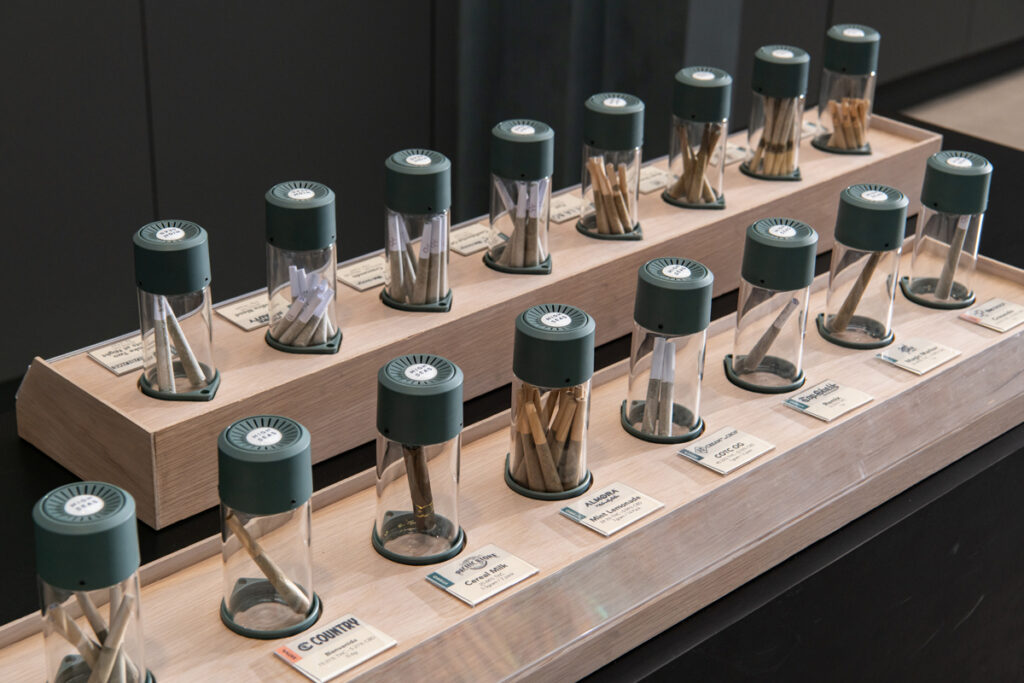
Overlooking sensory opportunities may masquerade as cost-cutting, say by simply slapping paint onto masonry block walls, thus missing the chance to solve a common sensory problem: noise. “Controlling sounds is a huge element that lots of folks do not pay enough attention to,” according to Patrick Donaldson, AIA, LEED AP, CPHC, principal architect at sustainability-centered Harka Architecture in Portland, Oregon.
Clamor echoing from concrete floors, high ceilings and other hard surfaces can be muffled with textures, from fabric-covered furniture to sound-absorbing panels. And choosing the right materials can represent a win-win, since solving noise pollution can be achieved without harming the environment, Donaldson said. He dulled the din at Fine Fettle Cannabis in Massachusetts by installing heavier textures, cushy seats, and three-dimensional felt acoustic ceiling tiles on the sales floor.
Such library-quiet tactics are vital at medical dispensaries and welcome at recreational ones, he said. “Because Fine Fettle was opened as a medical facility, we also needed to be aware of HIPAA [the Health Insurance Portability and Accountability Act, a set of federally mandated privacy rules], so we soundproofed several rooms for private medical conversations.”
Today, the store serves both medical patients and recreational consumers, “but I don’t feel that has much impact on the interior vibe,” he said.
Speaking of vibes, Donaldson said new customers may be nervous and feel intimidated when entering a cannabis establishment for the first time. “A quiet and warm environment can go a long way in helping them be at ease,” he said. “The trend is to create a cozy space, so people don’t feel rushed if they want to linger. And lingering can convert to sales.”
Sensory aspects also should match the desires of a store’s target market. Gen Z responds to the excitement and the throbbing beats at Stiiizy, a California and Michigan chain, according to Gi Paoletti, principal at Gi Paoletti Design Lab in San Francisco and Los Angeles.
“Gen Z definitely enjoys a more immersive experience while in-store shopping, which includes good music, live podcasts, Instagram-able moments and the ability to personalize products, all of which we considered in our design of Stiiizy stores and others,” she said.
As for baby boomers, they prefer to hear themselves think, Paoletti added.
But there are notable exceptions, said Desmond Chan, creative director at SevenPoint Interiors in Woodbridge, Canada. “It’s important your music selection complements your brand ethos, whether it’s a calm and inviting environment you’re after or playing Grateful Dead oldies in Scarlet Fire’s Grateful Dead-inspired dispensary we designed in Toronto.”
Speaking of older audiences: Graphics should suit the décor and brand image, too—but they also must be legible, Remedy Design Group’s Lam said. And she advised operators to stay on theme—but embrace at least a little restraint. “It may sound fun now to go all-out, and it may attract a social-media frenzy in the beginning,” she said. “But you have to consider whether [the design or operational element] makes sense long-term and from a maintenance perspective.”
In other words, adding a moveable sculpture rather than something that permanently hogs a major chunk of floor space may be the more practical choice.
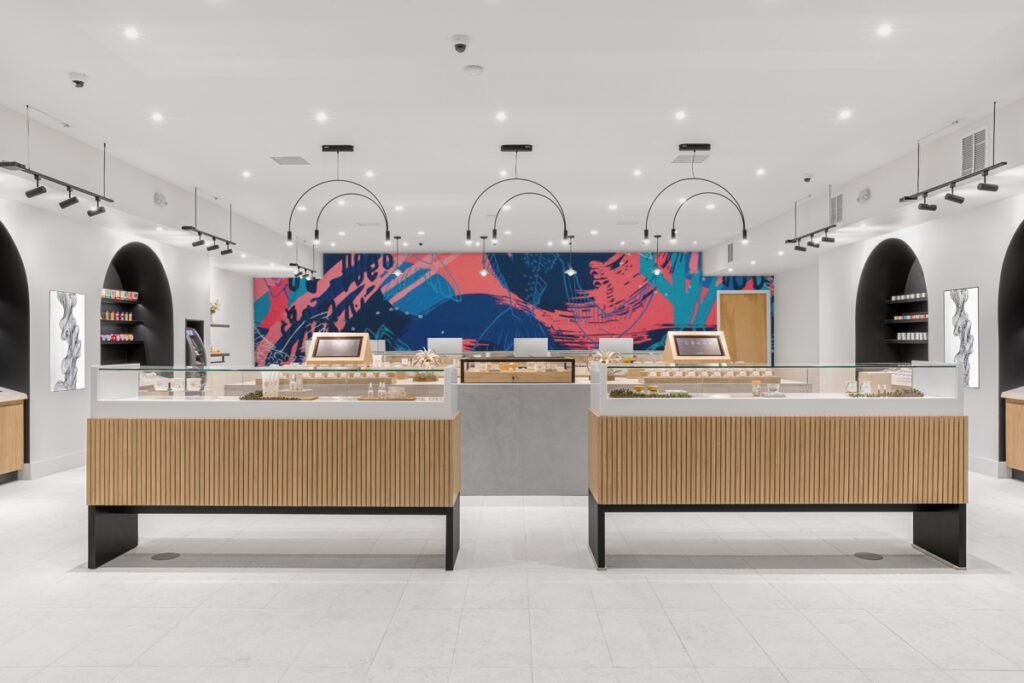
Similarly, when it comes to colors, don’t go crazy, she said. Rather than a chaotic rainbow, have a primary color and an accent color, and if another tint is necessary or desired, limit that color to less than 10 percent of the décor, perhaps by adding greenery or artwork.
Phasing out: Hiring interior designers post-construction.
Trending in: Hiring designers early in the process.
A dispensary’s design extends far beyond colors, display fixtures, lights, and brand identity. That’s why operators must mull the community, competitors, and retail categories before sinking money into real estate.
“A well thought-out and curated store is more impactful than a huge, empty one,” Lam said. “I’ve seen so many people invest in properties that are far beyond what they need. You’ve got to know beforehand whether the store will be a grab-and-go community store, an experiential store where customers linger and learn, or a tourist destination.”
Then you can plan space and number of product SKUs accordingly.
“When I begin a project, I ask clients, ‘What is your budget? What product categories are you considering and what percentage of each?’ A successful design starts with the client thinking about their customers’ needs and how they shop,” Lam said, adding some products dictate their placement, display, and electrical needs.
Be certain when deciding where to put high-tech stations, built-in fixtures, open shelves, tabletops, and refrigerators—and make the ruling before laying concrete and framing in walls. Otherwise, construction delays and a budget going up in smoke become major risks.
“Afterthoughts can be costly if they require tearing out walls or floors,” Lam said.
Phasing out: Hiring an all-in-one contractors.
Trending in: Hiring specialists.
As the saying goes, a person can be a jack of all trades but a master of none. Don’t make the common mistake of engaging one person to do everything.
“Some cannabis owners think they can hire one person to do it all, but just as a baker may not be the best sushi-maker, a graphic designer may not understand how product sizes affect shelf spacing,” Lam said.
None of this means the experts eventually hired won’t work together. “But it’s important to know who does what,” she said, “and let experts focus on what they do best.”
Phasing out: Printed menus and pamphlets.
Trending in: High tech.
In crowded Manhattan and elsewhere, touch-screen technology can keep customers up to speed in stores hampered by square-footage limits. After all, there’s always new brands and products to check out, and shoppers appreciate technology that provides more information about things with which they’re unfamiliar.
Temeka Group’s Wilson said touch-screen technology serves both the customer who wants to grab and go as efficiently and effectively as the customer who wants education about product types and THC levels. “You can call ahead or use a touch screen at a kiosk to order pre-rolls and edibles, and then pick them up at the express window just like you would take-out food,” he said. And that’s much needed in dispensaries, since “it’s not like they can advertise on TV.”
Technology can help behind the scenes, as well. Most point-of-sale systems also include inventory-management features, allowing operators to keep tabs on product and staffing needs. Digital in-store menus allow stores to flaunt their latest wares right away instead of having to wait for printed collateral.
Phasing out: Massive budgets.
Trending in: Skillful spending.
Las Vegas can put on the glitz. That’s expected in a town that glitters and glows from rhinestone bottom to neon top. But dispensaries may need to trim the fat while maintaining creativity.
“A little lipstick, so to speak, can make your dispensary sexier and more appealing,” Wilson said.
That may mean simply heading to an art supply store for a new hue. Color has long been a cost-effective way to freshen up a design—or create an entirely different look, according to Paoletti. “You can do much with painter’s tape and a few gallons of paint,” she said. Guided by portfolios, you also could hire a talented but fledgling artist to make a mural of your logo at a low cost.

Dispensaries also can go graphic—easily—by creating texture with vinyl wall decals that come in many sizes and prints. “People think of [applying decals] in their children’s rooms, but they don’t think about doing it in a store,” Paoletti said. “You also can order a custom decal of your logo.”
Marble may be out of your budget, but you can obscure concrete block walls with wooden ribs, as Temeka Group did for ASHE Society in California.
Another strategy is to hire designers who use pre-built modular displays versus custom ones. Display Dispensary, SevenPoint Interiors, and Temeka Group all offer pre-built cases.
“Every dollar counts when you build a business in the cannabis industry,” said ASHE Society owner Elaine Lu. She estimates Temeka Group saved tens of thousands of dollars in the design of her dispensaries, from concept to millwork and from fixtures to dimensional signage.
Dispensary owners also can profit from others’ misfortune: Jewelry and clothing stores that are going out of business may have useful fixtures—and at close-out prices, said former Scottsdale dispensary designer Megan Stone, now the creator of Bong Candles, a line of scented light-ups in reusable smokeware.
And of course, creating your own witty line of products enables you to live the high life—your way.







